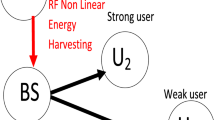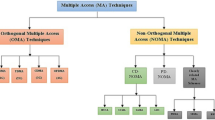Abstract
Sparse code multiple access (SCMA) is a novel code domain non-orthogonal multiple access scheme that enables the overloading of the fifth generation multi-user system. SCMA accommodates massive user connectivity, higher spectrum efficiency, low latency, flexible service multiplexing, etc. Integrating SCMA with cognitive features empowers the exploration of more frequencies under the spectrum scarcity issues. This paper proposes spectrum sensing with SCMA technology with an maximum passing algorithm (MPA) detector for multi-user detection at the receiver side. A novel double threshold based log-likelihood ratio MPA detector has been used for spectrum sensing in cooperative cognitive radio networks for Rayleigh fading, Rician fading and generalized Nakagami fading channel. The analytical detection performance versus signal to noise ratio (SNR) curve has been compared with the simulation results for the corresponding fading channels. The simulation results verify the SCMA-based system model performance in terms of detection probability well matched with analytical results. The paper also includes the comparative study of detection probability vs SNR under Rayleigh, Rician and Nakagami fading channel.












Similar content being viewed by others
References
Akyildiz I F, Lee W Y, Vuran M C and Mohanty S 2006 NeXt generation/dynamic spectrum access/cognitive radio wireless networks: A survey. Computer networks 50: 2127–2159
Kumar S, Sahay J, Mishra G K and Kumar S 2011 Cognitive Radio Concept and Challenges in Dynamic Spectrum Access for the Future Generation Wireless Communication Systems. Wireless Personal Communications 59: 525–535
Vaezi M, Ding Z and Poor H V (eds) 2019 Multiple access techniques for 5G wireless networks and beyond. Springer, Berlin, pp 167–193
Dai L, Wang B, Ding Z, Wang Z, Chen S and Hanzo L 2018 A survey of non-orthogonal multiple access for 5G. IEEE communications surveys & tutorials 20: 2294–2323
Akbar A, Jangsher S and Bhatti F A 2021 NOMA and 5G emerging technologies: A survey on issues and solution techniques. Computer Networks 190: 107950
Dai L, Wang B, Yuan Y, Han S, Chih-Lin I and Wang Z 2015 Non-orthogonal multiple access for 5G: solutions, challenges, opportunities, and future research trends. IEEE Communications Magazine 53: 74–81
Wang B, Wang K, Lu Z, Xie T, and Quan J 2015 Comparison study of non-orthogonal multiple access schemes for 5G IEEE International Symposium on Broadband Multimedia Systems and Broadcasting IEEE: 1–5
Chen Y, Bayesteh A, Wu Y, Han S, Taherzadeh M, Chen D and Ma J 2016 SCMA: A promising non-orthogonal multiple access technology for 5G networks. In 2016 ieee 84th vehicular technology conference (vtc-fall) IEEE: 1–6
Nikopour H and Baligh H 2013 Sparse code multiple access IEEE 24th Annual International Symposium on Personal, Indoor, and Mobile Radio Communications (PIMRC) IEEE: 332–336
Ding Z, Zhu Y and Chen Y 2019 Conclusions and future research directions for NOMA. Multiple Access Techniques for 5G Wireless Networks and Beyond: 669–677
Hosseini H, Anpalagan A, Raahemifar K and Erkucuk S 2017 Wavelet-based cognitive SCMA system for mmWave 5G communication networks. IET Communications 11: 831–836
Hamdani F and Arifianto M S 2018 On the Performance Evaluations of Uplink Cognitive Femtocell SCMA Systems Under Imperfect Channel Sensing. 4th International Conference on Wireless and Telematics (ICWT) IEEE: 1–5
Ghamry W K and Shukry S 2020 Performance evaluation of cooperative eigenvalue spectrum sensing GLRT under different impulsive noise environments in cognitive radio. Computer Communications 160: 567–576
Zhao Y, Song M and Xin C 2011 A weighted cooperative spectrum sensing framework for infrastructure-based cognitive radio networks. Computer communications 34: 1510–1517
Shekhawat GK and Yadav RP 2020 Sparse code multiple access based cooperative spectrum sensing in 5G cognitive radio networks. In 2020 5th International Conference on Computing, Communication and Security (ICCCS) IEEE: 1–6
Kumar A, Saha S and Tiwari K 2019 A double threshold-based cooperative spectrum sensing with novel hard-soft combining over fading channels. IEEE Wireless Communications Letters. 8: 1154–1158
Ameur WB, Mary P, Dumay M, Hélard JF and Schwoerer J 2019 Performance study of MPA, Log-MPA and MAX-Log-MPA for an uplink SCMA scenario. In 2019 26th International Conference on Telecommunications (ICT) IEEE: 411–416
Ma Z and Bao J 2019 Sparse code multiple access (SCMA). Multiple Access Techniques for 5G Wireless Networks and Beyond: 369–416
Naderpour M, Ghobadzadeh A, Tadaion A and Gazor S 2015 Generalized wald test for binary composite hypothesis test. IEEE Signal Processing Letters 22: 2239–2243
Zhou Y and Zhang L R 2012 Knowledge-aided Bayesian radar adaptive detection in heterogeneous environment: GLRT, Rao and Wald tests. AEU-International Journal of Electronics and Communications 66: 239–243
Verma P K, Soni S K and Jain P 2018 Performance evolution of ED-based spectrum sensing in CR over Nakagami-m/shadowed fading channel with MRC reception. AEU-International Journal of Electronics and Communications 83: 512–518
Kumar A, Thakur P, Pandit S and Singh G 2020 Threshold selection and cooperation in fading environment of cognitive radio network: Consequences on spectrum sensing and throughput. AEU-International Journal of Electronics and Communications 117: 153101
Saha S, Kumar A and Bhattacharya R 2017 An LLR based cooperative spectrum sensing with hard-soft combining for cognitive radio networks. In 2017 XXXIInd General Assembly and Scientific Symposium of the International Union of Radio Science (URSI GASS) IEEE: 1–4
Zou Q, Zheng S and Sayed AH 2009 Cooperative spectrum sensing via sequential detection for cognitive radio networks. In 2009 IEEE 10th Workshop on Signal Processing Advances in Wireless Communications IEEE: 121–125
Alvi S A, Younis M S, Imran M and Amin F 2014 A log-likelihood based cooperative spectrum sensing scheme for cognitive radio networks. Procedia Computer Science 37: 196–202
Guo H, Jiang W and Luo W 2017 Linear soft combination for cooperative spectrum sensing in cognitive radio networks. IEEE Communications Letters 21: 1573–1576
Beaulieu N C and Cheng C 2001 An efficient procedure for Nakagami-m fading simulation. In GLOBECOM’01. IEEE Global Telecommunications Conference (Cat. No. 01CH37270) IEEE 6: 3336–3342
Digham FF, Alouini MS and Simon MK 2003 On the energy detection of unknown signals over fading channels. In IEEE International Conference on Communications 2003 ICC’03 IEEE 5: 3575–3579
Sergienko A B and Klimentyev VP 2017 Spectral efficiency of uplink SCMA system with CSI estimation. In 2017 20th Conference of Open Innovations Association (FRUCT) IEEE: 391–397
Author information
Authors and Affiliations
Corresponding author
Appendix: An appendix section
Appendix: An appendix section
Rights and permissions
Springer Nature or its licensor (e.g. a society or other partner) holds exclusive rights to this article under a publishing agreement with the author(s) or other rightsholder(s); author self-archiving of the accepted manuscript version of this article is solely governed by the terms of such publishing agreement and applicable law.
About this article
Cite this article
Shekhawat, G.K., Yadav, R.P. Detection performance analysis for SCMA based cooperative spectrum sensing under different fading channels. Sādhanā 49, 93 (2024). https://doi.org/10.1007/s12046-024-02438-7
Received:
Revised:
Accepted:
Published:
DOI: https://doi.org/10.1007/s12046-024-02438-7




